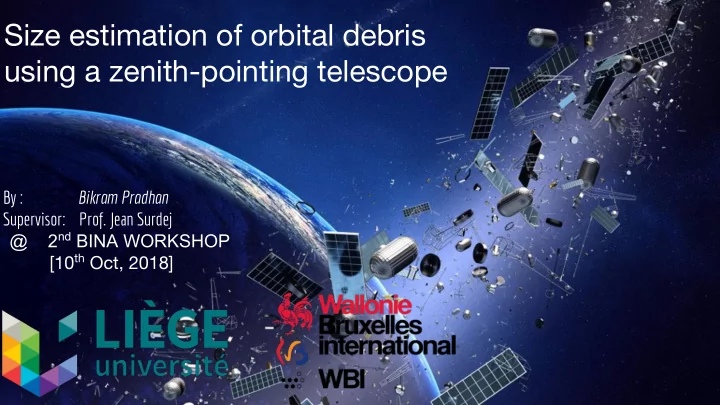

Size estimation of orbital debris using a zenith-pointing telescope By : Bikram Pradhan Supervisor: Prof. Jean Surdej @ 2 nd BINA WORKSHOP [10 th Oct, 2018]
A greener planet ?
OUTLINE ➔ Space awareness ➔ Optical observations of Space Debris ➔ Characterization ➔ Conclusion and Future perspectives
Space situational awareness What is out there ? ● Man-made objects that are in orbit around the Earth that no longer serve any useful purpose to us. ● Used rocket stages and defunct satellites to explosion fragments, paint flakes, dust, slag from solid rocket motors. ● Currently, 200 new objects are added annually.
Space situational awareness Why is this bad ? ● Erosive damage to satellites, when they come into contact with clouds of very small particles in space. ● Collisions can be highly damaging to satellites due to the extremely high orbital velocities (tens of thousands of km/h)
Space situational awareness LEO (Low-Earth Orbit) MEO (Medium-Earth Orbit) GEO (GEostaionary Orbit) Up to 2,000 km Between 2,000 and 35,000 km Around 35,000 km
Space situational awareness Number of objects in Earth orbits cataloged by US Space Surveillance Network Source : https://www.esa.int/Our_Activities/Operations/Space_Debris/Analysis_and_prediction
Space situational awareness ~ 8 % are functional satellites !!! Number of objects in Earth orbits cataloged by US Space Surveillance Network Source : https://www.esa.int/Our_Activities/Operations/Space_Debris/Analysis_and_prediction
Space situational awareness Number of objects in LEO as estimated from various measurements. SOURCE: National Aeronautics and Space Administration.
Space situational awareness unreliable !!! Number of objects in LEO as estimated from various measurements. SOURCE: National Aeronautics and Space Administration.
Optical observation of space debris 4-m International Liquid Mirror Telescope 1.3-m Devasthal Fast Optical Telescope (ILMT) (DFOT)
Optical observation of space debris Time Delay Integration / Drift scan δ t(final) t(initial) 42 sec 0 sec DFOT α 102 sec 0 sec ILMT
Optical observation of space debris Data Processing : Dark subtraction :
Optical observation of space debris Data Processing : Flat field correction :
Optical observation of space debris Data Processing : Sky subtraction : sliding average method + two_dimensional polynomial fit
Optical observation of space debris Photometry : Astrometry : ● Precision = 0.1 arcsec ● Precision = 0.04 mag
Optical observation of space debris Debris Observation
Optical observation of space debris
Identification By crossmatching : position and orientation of streak, With Entries in two-line-element (TLE)
Characterization
Characterization Diffuse Lambertian Sphere Albedo = 0.175 ( Hejduk et al., 2011 )
Results
SSN Cataloged Our estimated Cataloged Cross-section (min) Cross-section Cross-section (max) 13070 24827 22689 29669 32271 4367 17582 22646 25770 16759
Summary ● Operating in TDI mode, observation is without interruption and are sensitive to any objects passing through their field of view. ● Diffuse-specular Lambertian sphere can be an acceptable model to derive effective optical size of Debris. ● ILMT will be able to detect ~10 times smaller objects as compared to DFOT.
Recommend
More recommend